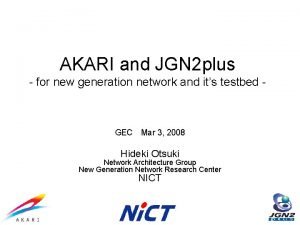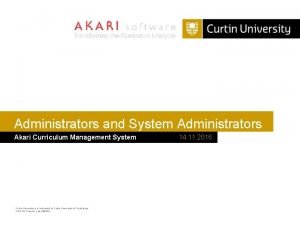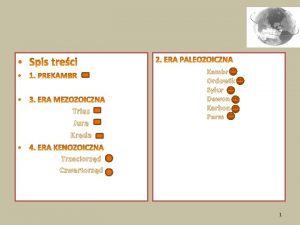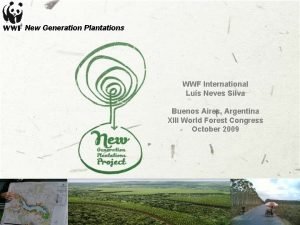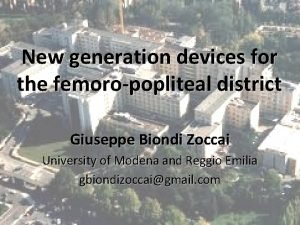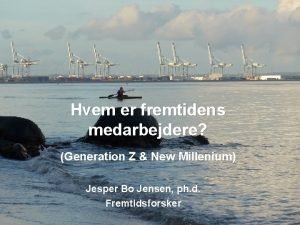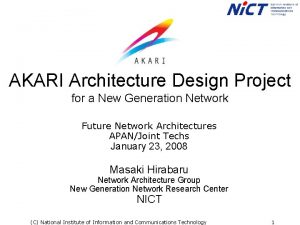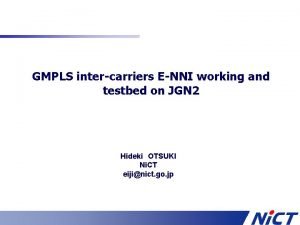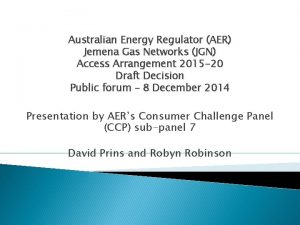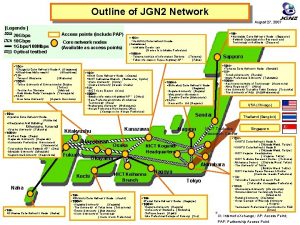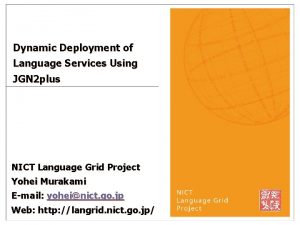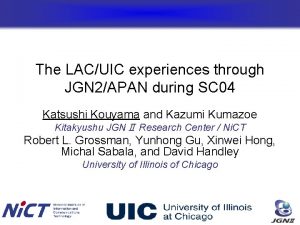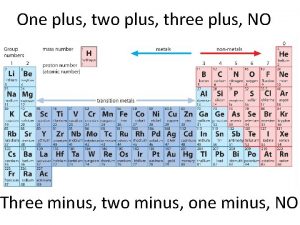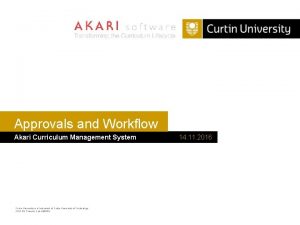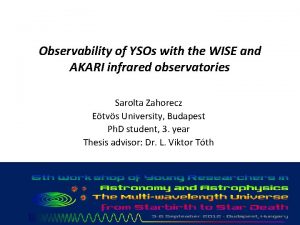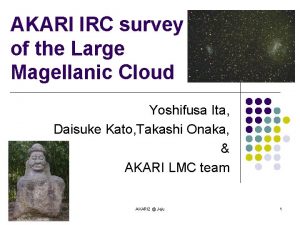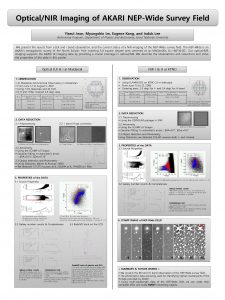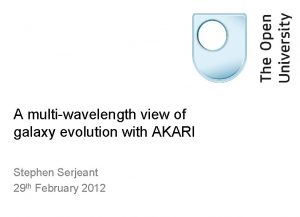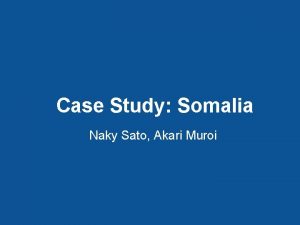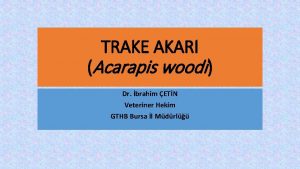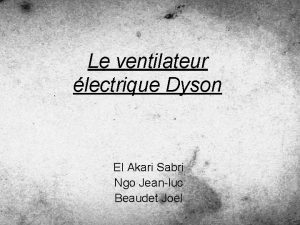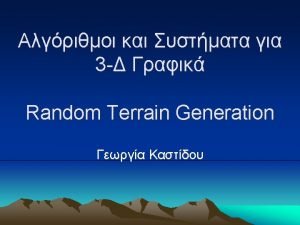AKARI and JGN 2 plus for new generation

























- Slides: 25

AKARI and JGN 2 plus - for new generation network and it’s testbed - GEC Mar 3, 2008 Hideki Otsuki Network Architecture Group New Generation Network Research Center NICT

What is AKARI • A research project for new generation network. – Clean slate approach – Started from small group studying for Architecture design. (an initial AKARI project) … AKARI Architecture Design Project – Movement for the new generation network promoted by NICT • “AKARI” is a small light in a dark. – To be a light pointing to the future.

AKARI Architecture Design Project Members: Network Architecture Group Leader: Hirabaru Harai (Photonic switching), Xu (Light Path), Miyazawa (Opt. Access), Morioka (Optical Transmission), Otsuki (Control), Jumpot, Inoue (Univ. Access), Nakauchi (Overlay), Kafle (Addressing), and Ohnish i. Network science by Prof. Murata (Osaka U. ) Ubiquitous by Prof. Morikawa (U. Tokyo) Mobility by Prof. Teraoka (Keio U. ) Packet switching by Prof. Ohta (Tokyo Inst. Tech. ) Network Virtualization by Prof. Aki Nakao (Univ. of Tokyo) Advisory: Program Director Prof. Aoyama, Executive Director Dr. Kubota

What’s “New Generation Network” or NWGN? Examples: Next Generations New Generation Network (NWGN) Cell Phones > 2 G > 3 G > 4 G? Internet > IPv 4 > IPv 6 > IPv? Revised NXGN New Generations 1) clean-slate 2) modification Past Network Present Network 2005 Next Generation Network (NXGN) 2010 2015

AKARI Architecture Design Plan - Grand-Designing a New Generation Network beyond 2015 2006 2011 2016~ JGN X Service & Operations Standardization Innovation “AKARI Architecture Conceptual Design” released in April 2007. English version in Fall, 2007. Field Trial Prototyping JGN 2 plus Overlay Network Testbed Design Testbed Construction NWGN Blueprint Proof of Concept Design (Now) Concept & Principles 10+ Researchers (NAG) NWGN Workshop (Open) AKARI Camp (Invite Only)

AKARI’s Current Focus: Network Architecture Role Safety & Security No vertical division. Common infrastructure Enjoy fundamental technology advances Ubiquity Energy-Saving Diversity Future requirements from diverse users and society Process Design Principles Network Architecture Select, integrate and simplify Evolving, future fundamental technologies proof Feedback -ofconcept Testbed (Overlay Network) All Optical Software Radio Theoretical Limits - Optimal Integration of many components - Stable enough to rely on for a long time - Grand-Designing a New Generation Network beyond 2015 - NETWORK SCIENCE Flexible to adopt a new user requirement Capacity (Peta)

AKARI Sustainable Architecture Principles Capacity for Quality 1. KISS (Keep It Simple, Stupid) • Crystal synthesis (select, integrate, simplify) • Common layer (layer degeneracy) • End-to-end (original Internet) 2. Reality Connected 3. Sustainable & Evolutional • ID-Locator separation • Bi-directional authentication • Traceability • • Reliable Network Space Self-* properties (emergent) Autonomic distributed control Scalable Social Selection For Future Diverse Society

Power Spectrum AKARI Architecture Components (I) – Optical & Wireless (1) Parallel Optical Packet Transmission Header Payload Sustainable in Capacity Sustainable in Management and Capacity (3) PDMA (Packet Division Multiple Access) Wavelength … Wide Shared Channel #N #3 #2 #1 A, B, C, D E, F, G, H, I, J, K, L, M, N, O, P, Q, R, S, T (2) All-Optical Path / Packet Switching Forwarding table RE Sustainable in Usage delay OPS buffer delay Data m 1 l Control / Data cl User a, b, c Look-up cl m 2 l link n 1 l OCS Peta-bps switching capacity Tera-bps link speed (40 G x 100) 100 billion tiny terminals Energy Saving – All optical n 2 l User a, b, c Packet (CSMA/CA) Only Free from: Frequency Band Allocations Cell Design (4) ID / Locator Separation - Generic ID Space - Authenticated, but - Keep privacy Sustainable in Mobility & Security Node Tag Hash Node Identifier ? + HIS name Node Name

AKARI Architecture Components (II) - New concepts (5) Overlay Network / Network Virtualization (6) Self-organizing Control Simultaneous Bad failures provisioning Chain Software reaction bug Efficient Robust Optimum Adapted Physical Networks Manageable Fast Recovery

CORE: Collaborative Overlay Research Environment Private Overlay network over JGN 2, WIDE, and SINET Led by Prof. Aki Nakao Joint project with: CORE Concept Sapporo • 10 sites, 52 servers • Multi-Homed • Testbed Federation • JGN 2+ NOC Coop. Collaborative Overlay Research Environment Sapporo Medical U. Tohoku U. Hakusan Network Virtulization Lab. Sendai Hiroshima U. Kanazawa Kyutech NII Nagano Nagoya Kitakyushu Tokyo Features we would like to have… Custom hardware to optimize overlay forwarding Po. P/Core collocation (nodes “inside” network) Custom hardware to optimize overlay forwarding Wireless/Sensors/Photonic capability in future Federation (e. g. Planet. Lab, One. Lab) Target overlay research Not just on distributed system apps More on network core architectures Utilize both private & public environments Tsukuba Okayama Overlay test-bed based on “Private Planet. Lab” Provision resources for mission critical services U. Tokyo Local v. s. Global / Provisioned v. s. Best-Effort New Generation Perspectives to Overlay Network Osaka. Keihanna Fukuoka Kochi-tech Osaka U. NICT Koganei NICT Otemachi - Testbed for prototype and evaluate a new generation network design - Evolutional nature of overlay network to incorporate into the design

AKARI NWGN (New Generation Network) R&D Plan 2006 07 08 09 10 11 12 13 14 15 Cooperative & Competitive Projects NWGN Community - Alternative Design - Network Security - Applications, etc. AKARI Architecture Design Overlay (Network Virtualization) JGN 2 Collaborative Projects CLEAN-SLATE APPROACH Social Requirements & Global Policy JGN 2+ Field Trials & Deployments Innovation Blueprint of NWGN JGN X (NWGN Testbed) Optical Packet Switch by NICT Cognitive Radio Photonic Network Phase I & II NGN Fundamental Technologies Dynamic Network Funded by NICT “AKARI Architecture Conceptual Design" English version released in Fall, 2007. http: //akari-project. nict. go. jp

Structure of Advancement of R&D for New Generation Network (NWGN) Collaboration of industry, academia and government; Objective sharing Concentration of intelligence among Industry, Academia and Government NICT Strategic Headquarter for NWGN R&D Strategy Working Group (R&D strategy planning) Active Participation, Taking lead Research Center Collaborative Research Dept. Join Company, University, etc. - Testbed - Commissioned Research NWGN Promotion Forum Input suggestion from industrial perspective to R&D strategy planning Join Advise NWGN Advisory Committee Strategy oriented R&D Knowledge from different field Strategy Promotion Join Study on R Strategy Study on S / Economic Influence Advanceme of Experime / Demonstra Vision Shar Education Advanceme of Internatio Collaboratio

What is JGN 2 plus • A new R&D network testbed – Post JGN 2 – Nation wide network – L 3, L 2 and photonic fiber – Testbed for network – Testbed for application

Mission of JGN 2 plus from a Viewpoint of Research • • Backbone for new R&D activities in network technology – Grid, Broadcasting applications • Advanced network service (ex. Light path, GMPLS) • Collaboration with SINET and other Grid projects, etc. – Ubiquitous, Sensor, P 2 P • Need New communication paradigm by overlay network – Planet Lab, PIAX • Collaboration with ubiquitous projects, specially appointed ubiquitous area, information explosion project, Live-E, etc. – Define Operation model for and migration path to new generation network Vehicle for Global Collaboration – International collaboration on E-science and NWGN research – International education, human resource development – Standardization, footprint for development of Service Platform Regional Collaboration – promotion of U-Japan Collaboration with other activities in NICT – Security, Starbed(Internet Realscale simulator) , Universal communication, Quantum communication, Space weather, e-VLBI

Target of JGN 2 plus - Toward Nationwide deployment of broadband network - Popularization of IPv 6 technology - Toward Implementation of Next Generation Internet (NGN / IPv 6) - R&D of Optical NW - Application Development - International Community - Toward Implementation of New Generation Network - R&D of Service Platform - International Experiments JGN 2 plus Post JGN 2 JGNII JGN 2 plus 1999 2000 2001 2002 2003 2004 2005 2006 2007 2008

Major changes from JGN 2 to JGN 2 plus R&D Structure JGN 2 (2004. 4 - 2008. 3) JGN 2 plus (2008. 4 – 2011. 3) R&D by seven research centers Service Platform Architecture Research Center (Research on specific topics under 4 -year plan) Operation SPARC Uniting operation and research as one structure to advance R&D for operation / management technology in NWGN NW Operation NW Services Network Operation Center (NOC) (Stable operation of L 2/L 3 service) -Optical Testbed Service -Nation-wide access points (64 APs) -International circuits (US, TH, SG R&D Advancement of NWGN testbed R&D -Optical Testbed Service -Nation-wide access points -International circuits (US, TH, SG, CN, KR) -Overlay service platform provisioning.

JGN 2 plus Services Available L 3: IP connection Network Services - IP interconnection among JGN 2 plus users, or among JGN 2 plus users and other research networks ü IPv 4/v 6 dual stack, IPv 6 Native (Full route), Core routers on main APs L 2: Ethernet connection - Point-to-point connection service: VLAN-based L 2 point-to-point interconnection - Multi-point connection service: VLAN-based L 2 multi-point interconnection ü Jumbo-frame support (over 1 G, 10 G lines) Optical Testbed - Hakusan – (8 fibers) – Otemachi – (16 fibers) – Koganei - for experiments of optical-level transmission Operation X R&D International circuits US TH SG CN Operation Service + R&D - Operation / management of circuits, equipments on APs - Service Platform Provisioning -Technical supports KR

JGN 2 plus Services (1) JGN 2 plus Network Outline *1: Access Point Chugoku *2: Internet Exchange [10 G] *3: Partnership Access Point -Chugoku (Okayama) -Hiroshima Motomachi (Hiroshima) [100 M] -Techno Arc Shimane (Shimane) -New Media Plaza Yamaguchi (Yamaguchi) [1 G] - Hiroshima Univ. (Higashi Hiroshima) *3 (Access to JGN 2 plus at APs of Okayama Information HW and Tottori Information HW is available via interconnection with these networks. ) [10 G] Kinki -Kinki (Osaka) -Osaka Univ. (Ibaraki) -NICT Keihanna (Seika) [1 G] -Kyoto Univ. (Kyoto) -NICT Kobe (Kobe) [100 M] -Biwako Information HW AP *1 (Otsu) -Wakayama Univ. (Wakayama) -Yamatoji Information HW AP *1 (Nara) -Hyogo Information HW AP *1 (Kobe) Kyushu [10 G] -Fukuoka (Fukuoka) -Kita Kyushu AIM Bldg. (Kita Kyushu) -Kyushu Univ. (Fukuoka) [100 M] -Net. Com Saga (Saga) -Nagasaki Univ. (Nagasaki) -Toyonokuni Hyper NW AP *1 (Oita) -Miyazaki Univ. (Miyazaki) -Kagoshima Univ. (Kagoshima) KR Hokkaido Hokuriku [1 G] -Hokuriku (Kanazawa) -Ishikawa Create Lab (Nomi) [100 M] -Toyama Institute of Information Systems (Toyama) -Fukui Super HW AP *1 (Fukui) [1 G] - Sapporo (Sapporo) Tohoku [10 G] -Tohoku (Sendai) -Tohoku Univ. (Sendai) [1 G] -Iwate Pref. Univ. (Takizawa) -Univ. of Aizu (Aizu Wakamatsu) [100 M] -Akita Regional IX *2 (Akita) -Hachinohe Institute of Technology (Hachinohe) -Yamagata Prefecture (Yamagata) Shinetsu [100 M] -Information & Communication Broadway Nagano AP *1 (Nagano) -Niigata Univ. (Niigata) -Densan (Nagano) *3 Kanto JGN 2 plus / APII Circuit Okinawa [1 G] -Okinawa (Naha) -NICT Okinawa (Onna) Shikoku [1 G] -Kochi (Kochi) -Kochi Univ. of Technology *3 [100 M] -Ehime Univ. (Matsuyama) -Kagawa Univ. (Kida-gun) -Univ. of Tokushima (Tokushima) Tokai [10 G] -Tokai (Nagoya) -Nagoya Univ. (Nagoya) [100 M] -Softopia Japan (Gifu) -Univ. of Shizuoka (Shizuoka) -Mie Pref. College of Nursing (Tsu) Optical Testbed Koganei – Otemachi Hakusan JGN 2 plus International Circuits US CN TH SG [10 G] -Kanto-A (Chiyoda-ku) -Kanto-B (Chiyoda-ku) -NICT Koganei (Koganei) -NICT Kashima (Kashima) -Univ. of Tokyo (Bunkyo-ku) [1 G] -IBBN Tsukuba AP *1 (Tsukuba) [100 M] -Utsunomiya Univ. (Utsunomiya) -Waseda Univ. , Honjo Campus (Honjo) -Reitaku Univ. (Kashiwa) -Gunma Industrial Technology Center (Maebashi) -Yamanashi Information HW AP *1 (Kofu) -YRP (Yokosuka)

JGN 2 plus Services (2) Optical Testbed Service (about 12 km) Koganei (about 50 km) Otemachi Low-loss SMF x 8 (4 pairs) Hakusan Low-loss SMF x 16 (8 pairs) • JGN 2 plus Optical Testbed Service Ø Koganei-Otemachi Section - about 50 km - Single mode optical fiber (ITU-T G. 652) x 8 - Low-loss SMF (within 20 d. B loss at 1550 nm band, without any transponders / amplifiers) Ø Otemachi-Hakusan Section - About 12 km - Single mode optical fiber (ITU-T G. 652) x 16 - Low-loss SMF (within 10 d. B loss at 1550 nm band, without any transponders / amplifiers)

R&D in JGN 2 plus SPARC MIC / NICT New Generation Network Promotion Forum Strategic Headquarters for NWGN R&D Other R&D activities in Internet / NGN areas NWGN Research Areas in NICT Application - Tele-Immersion - Time Synchronization /Distribution NW Virtualization - Five Nines - User Opt-in, etc. Optical NW Wireless - Cognitive - FMC, etc. - Optical Grid - Light Path Integration International R&D NWs Photonic NW - Quantum communication Cryptography - Optical Packet, etc. JGN 2 plus SPARC (at Otemachi) Research Topic 1 Research Topic 2 Research Topic 3 Research Topic 4 R&D on NWGN Service Platform Fundamental Technology (Shimojo) R&D on NWGN Service Testbed federation technology (Nakayama) R&D on middleware and Application of Light Path NW (Otsuki) Establishment of Component Technologies for NWGN Operation (Esaki) - Distributed Data Fusion Technology - Structured / Adaptive Overlay Technology - Multi-layer Overlay NW Integration / Evaluation Technology - Cutting-Edge Application - Network Monitoring - Interoperability Test / Standardization - Traffic Management - P 2 P Traffic Engineering - NGN / IMS-SIP Operation Research Topic 5 Verification of Technologies for International NW Operation (Kitamura) - Status Monitoring / NW Control - Evaluation of Advanced Domestic / Global NW Systems Technology Testbed Network Operation (Kobayashi, Yamamoto) General R&D Projects (150) Invited R&D Projects (2 -3)

JGN 2 plus Services (3) JGN 2 plus International Circuits (L 2/L 3) GLORIAD CA*net 4 (USA, Russia, China) (Canada) GEANT 2 (Europe) APAN (Asia) TEIN 2 (Asia, Europe) KOREN (Korea) CERNET (China) KR Tokyo Pacific. Wave (USA) CSTNET (China) Uni. Net (Thailand) BKK Thai. Sarn (Thailand) UKLight (UK) IEEAF (USA) HK Trans. PAC 2 (USA) SG Sing. AREN (Sing. AREN) AARNet (Australia) LA Chicago Star. Light (USA) SURFnet (Netherland) MREN (USA) Internet 2 NLR (USA) US-JP line : Tokyo-Los Angeles-Chicago, 10 Gbps TH-JP line : Tokyo-Bangkok, 45 Mbps SG-JP line : Tokyo-Singapore, 155 Mbps KR-JP line (APII) : Fukuoka-Busan, 10 Gbps HK-JP line : Tokyo-Hong Kong, 2. 4 Gbps

International Collaboration • Japan-US Link - 10 Gbps (Tokyo-Los Angels-Chicago) - Interconnection with Pacific wave (Los Angels), and Starlight (Chicago) • Japan-Singapore Link - 155 Mbps - Interconnection with Sing. AREN • Japan-Thailand Link - 45 Mbps - Interconnection with Thaisarn • Japan-Korea link – 10 Gbps – Interconnection with KOREN • Japan-Hong Kong link – 2. 5 Gbps – Interconnection with CSTNET and CERNET – Mutual backup with TEIN 2

Three Pillars for Advancement of NWGN By NICT itself I. Establishment of “Strategic Headquarters for NWGN R&D” (Oct 2007) As ALL Japan II. Establishment of “NWGN Promotion Forum” (Oct 2007) For advancement of experimetns / demonstrations III. Construction of “Network for Network Experiment” (JGN 2 JGN 2 plus)

Research Activities about JGN 2 plus and NWGN JGN 2 plus is a testbed network to support R&D of NWGN promoted by NICT. It also plays a role of supporting R&D activities in JGN 2 plus research center (Service Platform Architecture Research Center: SPARC). New Generation NW (NWGN) Improvement of international competitiveness Strategic advancement of R&D by collaboration of industry, academia and government Re-design of NWGN from scratch toward Activities NWGN International Competition and Collaboration Research Activity in JGN 2 plus research center (plan) R&D of NWGN Operation / Management Technology s -High speed, Diversity EU (FP 7, etc. ) ent -High availability & quality m e ir Next Generation NW Asia -Secure, Energy saving equ work r (NXGN) l et -Action to unknown problem. Collaboration of Industry, cia Limit of So for n Academia and Government existing Internet technology Collaboration Data NW JGN Before Cellular JGN 2 - Complexity by added functions - Limit of performance improvement PSTN JGN 2 plus Now Current Network Lead US (FIND, etc. ) Global Trend toward NWGN (FIND, FP 7, etc. ) PSTN Collaboration Y 2010 (Next Generation) Next Generation Network (NXGN) NWGN Promotion Forum New Testbed Y 2015 (New Generation) New Generation Network (NWGN)

Activities on NWGN Research and Testbed in US / EU / Japan/… US FIND - Research funding program aiming at establishing future Internet architecture - Clean-slate approach - Focusing on comprehensive research of network architecture design - Many small projects are adopted and converged to a few full-scale architectures. Those architectures will be examined on GENI infrastructure. GENI Initiative - Succeeding to the result of Planet Lab - Programmable - Aiming at innovation by fundamental reconsideration of service architecture to overcome problems of current Internet - Research scopes: Security, Mobile / Wireless, Sensor NW, etc. - Trying to secure budget from MREFC - International collaboration is also in a scope. EU FP 7 - R&D funding program to support to secure technological improvement and competitiveness of universities and companies in Europe < Related projects> 1. The network of the future 2. Service and software architectures, Infrastructures and Engineering 3. Secure, Dependable and Trusted Infrastructure 4. Networked Media GÉANT 2 - Giga-bps R&D network covering all over Europe area, funded by EU committee. - Interconnecting 34 NRENs in EU. - Over 3, 000 research organizations in Europe can share information about research activities. - Migration to GEANT 3 is planned in 2008; improving bandwidth and functionality. Japa n AKARI (独)情報通信研究機構(NICT)の研究者グ NICT promotes NWGN research activity ループが中心となり、新たなネットワーク “AKARI Architecture”, aiming at アーキテクチャの確立と、それに基づいた implementation of NWGN via ネットワーク設計図の作成を目的としたプロ establishing new NW architecture / ジェクト「AKARI」が立ち上げられた。 design and experiments. The concept AKARIプロジェクトでは、議論を重ね、2007 paper of NWGN architecture was 年 4月に、新ネットワークアーキテクチャの published in Apr 2007. NICT 原理と手法、基本構成、その検証のための established Strategic Headquarter for テストベッドに対する要求条件等からなる「 NWGN R&D in Oct 2007 to build up 新世代ネットワークアーキテクチャAKARI strategic roadmap of R&D and to 概念設計書」を取りまとめ、公表。 promote it. AKARIプロジェクトのURL: http: //akari. JGN 2 plus project. nict. go. jp/ - R&D testbed network operated by NICT with nation-wide access points, utilized to R&D activities and experiments through collaboration of industry, academia and government. - Contributing to human resource development in ICT area via experience of practical experiments. - NICT modifies existing JGN 2 network and starts operation of “JGN 2 plus” from next fiscal year, as a testbed for NWGN researches, R&D of NW technology, etc. NICT will promote R&D of completely new NW architecture in Y 2020 to secure international competitiveness by taking advantage of optical NW technology, ubiquitous NW technology, etc.
 Jgn architecture
Jgn architecture Akari curtin
Akari curtin Akari curtin
Akari curtin First generation antipsychotics vs second
First generation antipsychotics vs second From generation to generation we worship you
From generation to generation we worship you The generation and exploitation of new entry opportunities
The generation and exploitation of new entry opportunities Plus haut plus loin que l'azur infini
Plus haut plus loin que l'azur infini Je contiens du sucre sans être sucré
Je contiens du sucre sans être sucré Ordowik kambr
Ordowik kambr Plus j'apprends plus je me rends compte de mon ignorance
Plus j'apprends plus je me rends compte de mon ignorance Idea development process
Idea development process Teachers the new generation will be your devotion
Teachers the new generation will be your devotion New joshua generation
New joshua generation New generation plantations
New generation plantations New generation devices
New generation devices Generation new millenium
Generation new millenium Generation of new entry opportunity
Generation of new entry opportunity Iso 22301 utbildning
Iso 22301 utbildning Novell typiska drag
Novell typiska drag Tack för att ni lyssnade bild
Tack för att ni lyssnade bild Returpilarna
Returpilarna Varför kallas perioden 1918-1939 för mellankrigstiden?
Varför kallas perioden 1918-1939 för mellankrigstiden? En lathund för arbete med kontinuitetshantering
En lathund för arbete med kontinuitetshantering Kassaregister ideell förening
Kassaregister ideell förening Personlig tidbok fylla i
Personlig tidbok fylla i A gastrica
A gastrica
